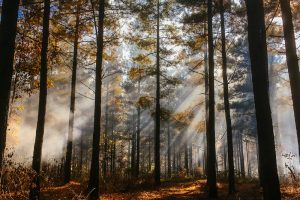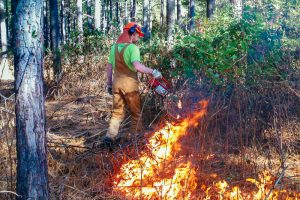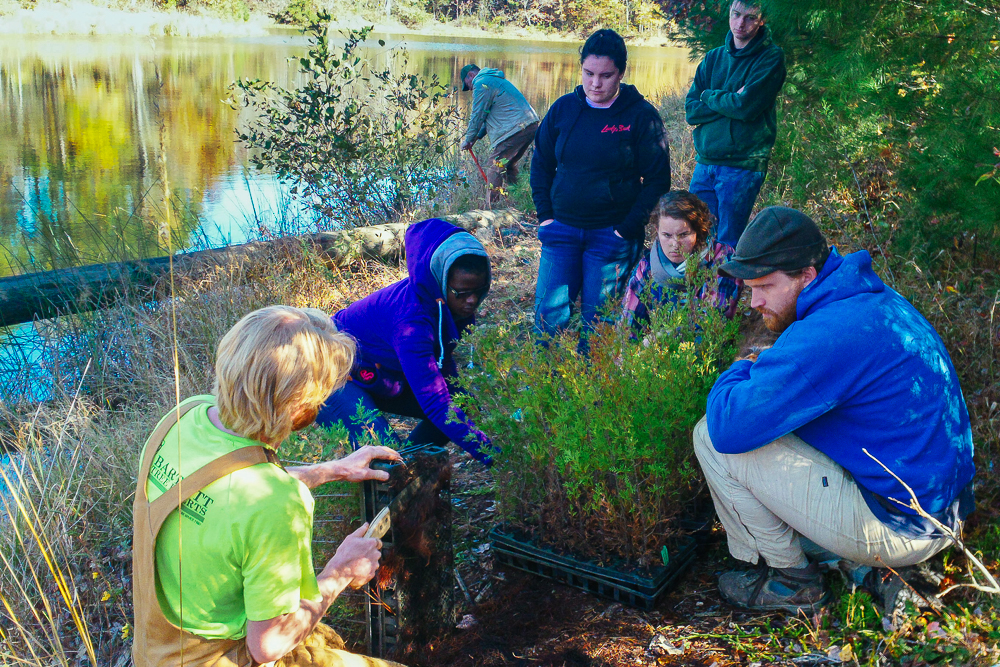Upon arriving at Piedmont Earthworks near Charlottesville, Virginia, eight students from Eastern Mennonite University were greeted by manager Chris Fields-Johnson and his dog, Fin. Over the next several hours, the group would be treated to a hands-on tour of his 300-acre agroforestry project, including tree planting, a controlled burn, a lesson on various wild herbs and plants, and a peek into Fields-Johnson’s work so far.

“We live in a world where it’s easy to have strong opinions without following through with strong action, and I refuse to go along with that,” said junior Adrienne Derstine, who came along on the excursion because of her strong belief that living sustainably must be accompanied by practice.
Jonathan McRay, sustainability curriculum coordinator, organized this trip for students, who represented several majors. He has been curious about Fields-Johnson’s work, but was most interested in the project’s holistic nature.
“Practically, I was very interested in seeing his soil-building efforts through onsite biochar. This is fairly rare these days, but it’s an ancient method for storing carbon in the soil and improving its fertility,” said McRay, who is also a restorative justice facilitator and garden manager at Vine and Fig/New Community Project.
Recreating longleaf pine savannas
Fields-Johnson graduated from Virginia Tech with a degree in forestry in 2008, and holds two graduate degrees in crop and soil environmental sciences including a newly awarded doctorate. He is also a certified arborist and controlled burn manager. Before attending Virginia Tech, he spent two years at James Madison University. While there, he worked in the arboretum which inspired him to pursue a forestry degree. Since then, he has been involved in agroforestry.
Fields-Johnson has been at his current location since 2004, and he hopes to continue his project for the long term. Over time, he wants to recreate the landscape of the longleaf pine savannas that previously covered parts of southeastern United States. Before that can happen, however, Fields Johnson encourages the proper understory growth and selectively thins the forest by removing less desirable trees.
During their visit, the EMU students tried their hand at planting Atlantic white cedar trees along the bank of a pond. Fields-Johnson explained that the young trees would eventually stretch their branches over the water and keep the pond, and the fish living in it, cooler during the summer as well as prevent soil erosion.
Fields-Johnson had two rules for planting trees: Don’t plant dead trees and plant trees deep. He then showed the students how to gently pull the baby trees out of the plastic tray, loosen the roots for maximum water absorption, and insert the roots into a hole approximately a foot away from the water.
Junior Angel Mallard was excited to learn that planting trees is easy, and now thinks everyone should know how to do it to conserve our environment.

Senior Jack Hummel, also interested in forestry, has seen firsthand effects of unhealthy timbering practices in his own back yard— “not a pretty sight,” he says, “Chris’ practices on the other hand help to show how very responsible and sustainable forestry practices can be economically viable.”
Burns encourage new growth
Students also witnessed a controlled burn which involves selectively lighting small areas of understory as a way of isolating carbon from the air and encouraging new growth on the forest floor. Fields-Johnson said after previous controlled burns, wildflowers sprouted.
Most students thought the fire would easily get out of control, but observed only the top layer of pine needles burned after Fields-Johnson set selected areas aflame with a drip torch filled with three parts diesel and one part gasoline. Before he began the burn, Fields-Johnson reported his activities to the county fire department.
Another sustainable practice Fields-Johnson employs is ecological grazing with a herd of about 15 Katahdin hair sheep. The sheep, and previously goats, move to a different part of the property every two weeks and eat the brush Fields-Johnson trims.
While Fields-Johnson has a full-time job in urban forestry and rents the land he works with, any money he makes from it from hunters, timber and summer camps gets invested in the project. When the trees were planted, and the dog had received plenty of affection, Fields-Johnson invited the students back in 20 years to see their work pay off.
